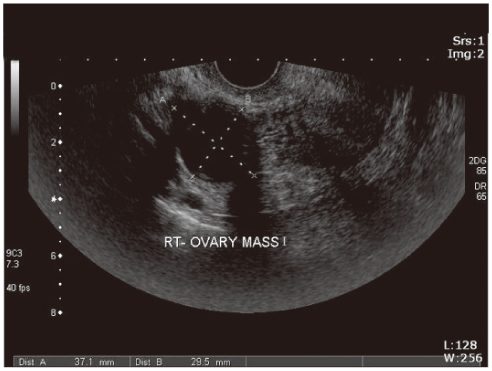Korean J Obstet Gynecol.
2012 May;55(5):366-369. 10.5468/KJOG.2012.55.5.366.
A case of unrecognized foreign body in the abdomen mimicking benign ovarian cyst
- Affiliations
-
- 1Department of Obstetrics and Gynecology, Hallym University College of Medicine, Seoul, Korea. vth2000@naver.com
- KMID: 2078157
- DOI: http://doi.org/10.5468/KJOG.2012.55.5.366
Abstract
- The most commonly detected foreign body in the abdominal cavity is surgical gauze or sponge, which is followed by intrauterine devices penetrating the uterine cavity. However, to the best of our knowledge, there has been no case report of a foreign body in the abdomen misdiagnosed as an ovarian cyst, in the literature. Thus, we report 1 case of a 41-year-old woman with an umbrella handle in the abdominal cavity, which was misdiagnosed as the ovarian cyst.
Keyword
MeSH Terms
Figure
Reference
-
1. Yamato M, Ido K, Izutsu M, Narimatsu Y, Hiramatsu K. CT and ultrasound findings of surgically retained sponges and towels. J Comput Assist Tomogr. 1987. 11:1003–1006.2. Botet del Castillo FX, López S, Reyes G, Salvador R, Llauradó JM, Peñalva F, et al. Diagnosis of retained abdominal gauze swabs. Br J Surg. 1995. 82:227–228.3. Gawande AA, Studdert DM, Orav EJ, Brennan TA, Zinner MJ. Risk factors for retained instruments and sponges after surgery. N Engl J Med. 2003. 348:229–235.4. Moyle H, Hines OJ, McFadden DW. Gossypiboma of the abdomen. Arch Surg. 1996. 131:566–568.5. Lincourt AE, Harrell A, Cristiano J, Sechrist C, Kercher K, Heniford BT. Retained foreign bodies after surgery. J Surg Res. 2007. 138:170–174.6. Yildirim S, Tarim A, Nursal TZ, Yildirim T, Caliskan K, Torer N, et al. Retained surgical sponge (gossypiboma) after intraabdominal or retroperitoneal surgery: 14 cases treated at a single center. Langenbecks Arch Surg. 2006. 391:390–395.7. Lauwers PR, Van Hee RH. Intraperitoneal gossypibomas: the need to count sponges. World J Surg. 2000. 24:521–527.8. Bani-Hani KE, Gharaibeh KA, Yaghan RJ. Retained surgical sponges (gossypiboma). Asian J Surg. 2005. 28:109–115.9. Kalovidouris A, Kehagias D, Moulopoulos L, Gouliamos A, Pentea S, Vlahos L. Abdominal retained surgical sponges: CT appearance. Eur Radiol. 1999. 9:1407–1410.10. Rajput A, Loud PA, Gibbs JF, Kraybill WG. Diagnostic challenges in patients with tumors: case 1. Gossypiboma (foreign body) manifesting 30 years after laparotomy. J Clin Oncol. 2003. 21:3700–3701.
- Full Text Links
- Actions
-
Cited
- CITED
-
- Close
- Share
- Similar articles
-
- A Case of Traumatic Epidermal Cyst Containing Glass Pieces
- Epidermal Cyst-like Skin Metastasis in Ovarian Cancer Patient
- Acute abdomen due to ovarian congestion caused by coiling of the fallopian tube accompanied by paratubal cyst around the utero-ovarian ligament
- An Unrecognized Foreign Body Retained in the Calcaneus: A Case Report
- A Case of Trichilemmal Cyst on the Abdomen




